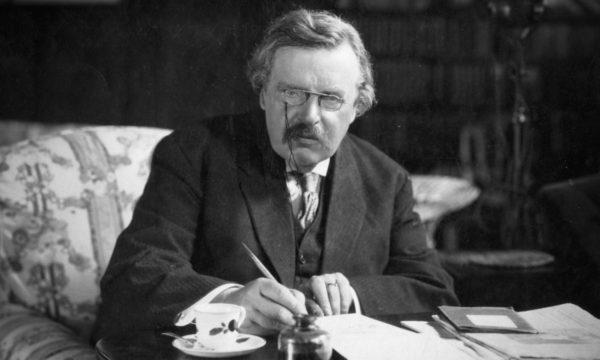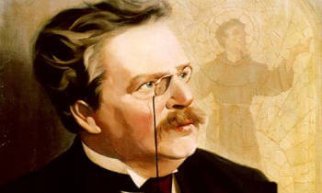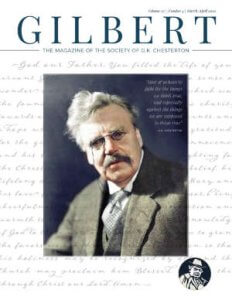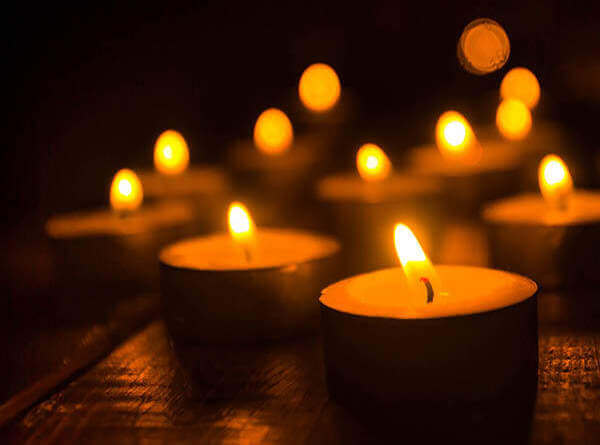Chesterton may have considered The Ballad of the White Horse his greatest literary accomplishment. I have two reasons for saying that. First of all, it is a masterpiece. But it was the only one of his works that he felt worthy enough to dedicate to his wife. The Ballad of the White Horse is one of the last great epic poems in the English language. It deserves a high place in literature. It is should be studied in depth and discussed at length and appreciated far and wide. But as is the case with most of Chesterton’s writings, too few of us have figured this out. The Ballad is the story of the English King Alfred, who fought the Danes in the year 878. But it is also the story of Christianity battling against the destructive forces of nihilism and heathenism, which is the battle we are still fighting.
At the beginning of the poem, the Blessed Virgin appears to King Alfred, and he asks her if he is going to win the upcoming battle. Her reply is not what he expects:
The gates of heaven are lightly locked,
We do not guard our gold,
Men may uproot where worlds begin,
Or read the name of the nameless sin;
But if he fail or if he win
To no good man is told. The men of the East may spell the stars,
And times and triumphs mark,
But the men signed of the cross of Christ
Go gaily in the dark. . .The wise men know what wicked things
Are written on the sky,
They trim sad lamps, they touch sad strings,
Hearing the heavy purple wings,
Where the forgotten seraph kings
Still plot how God shall die. . .But you and all the kind of Christ
Are ignorant and brave,
And you have wars you hardly win
And souls you hardly save.I tell you naught for your comfort,
Yea, naught for your desire,
Save that the sky grows darker yet
And the sea rises higher.Night shall be thrice night over you,
And heaven an iron cope.
Do you have joy without a cause,
Yea, faith without a hope?
The Church teaches that the two sins against hope are presumption and despair. We must not be either triumphalist or defeatist. We must not be either smug or suicidal. We do not know the outcome of the battle. We are not guaranteed victory – even if we fight for what is right. The message of this poem is that it is up to us to choose the right side, even if there is a risk that it is not the winning side. It is enough to know what we are fighting for. That is the meaning of faith and hope. That is the meaning of going “gaily in the dark.” King Alfred gets no encouraging words from Mary. And yet, strangely enough, he is encouraged. He gets naught for his comfort and naught for his desire, yet he is comforted, and emboldened in his desire to fight the foe.
King Alfred goes off to recruit an army and fight the Danes. He also goes undercover into the Danish camp, dressed as a wandering minstrel. He sits by the enemy fire with his harp and hears from their own lips their empty and dangerous philosophy, a truth that “is cold to tell,” that “the soul is like a lost bird,” and “the body a broken shell.” When he returns to his own camp, still in disguise, he is stopped by an old woman who is roasting cakes over a fire. She tells him to watch the cakes while she goes about some other task. Alfred sits philosophizing about the menial role of this woman, and naturally, lets the cakes burn. The woman comes and strikes him across the face, leaving a scarlet scar. She does not know she has just slapped the King, but Alfred stands up and laughs, and realizes that he who “is struck for an ill servant/Should be a kind lord.”
Having learned this crucial lesson about humility, Alfred is ready for battle. He vows to return the blow he has received, not, of course, at the old woman, but at the enemy. He and his army charge into combat to fight a fight that does not seem winnable. And yet they win. But after his great victory, Alfred, who calls himself “a common king,” prophesies that the heathen shall return.
They shall not come with warships,
They shall not waste with brands,
But books be all their eating,
And ink be on their hands. . .By terror and the cruel tales
Of curse in bone and kin,
By weird and weakness winning,
Accursed from the beginning,
By detail of the sinning,
And denial of the sin.
Sin is a weed. It starts out small and subtle. But left unattended it becomes an infestation, and covers everything. Which brings us to the image of the White Horse. High on a Berkshire hill overlooking the valley where Alfred fought the Danes, is an ancient image of a White Horse. The silhouette was formed long ago when the turf covering the underlying chalk was removed, setting off the distinct white figure against the green hillside. But people must continually clear away the creeping grass and weeds, or else the image would disappear.
Alfred’s first act after defeating the Danes at Ethandune is to gather his people together and scour the White Horse again, which the barbarians had left to be overgrown by weeds. It is because of this “act of will and intelligence” against the natural elements, an act repeated by people across the centuries, that we still see the silhouette of the horse as it was seen in King Alfred’s time.
Chesterton uses this mysterious image as a symbol of the traditions that preserve mankind. Our parents have taught us certain truths, certain commandments; we in turn teach them to our children. If we do not teach them, soon comes “the detail of the sinning and the denial of the sin.” The moral tradition of the human race is never secure. It is active, hard work. We can never take it for granted. As the Russian Chesterton Scholar, Ekaterina Volonkhonskaia, says, “If we do not clear the outline of the White Horse with unwearying care, grass will very soon choke it and we will lose it forever. It is not the moral tradition that keeps us, it is we who keep (or do not keep) it.”
[Note: A beautiful edition of the Ballad has been reprinted by Ignatius. It contains an introduction and extensive endnotes by Sister Bernadette Sheridan, IHM, who researched the poem and the battle of Ethandune for 60 years. And don’t forget the audio tape of the Ballad, which is read by Aidan Mackey, another lifelong student of Chesterton’s rolling meter. Both the book and the tape can be ordered from the American Chesterton Society.]





